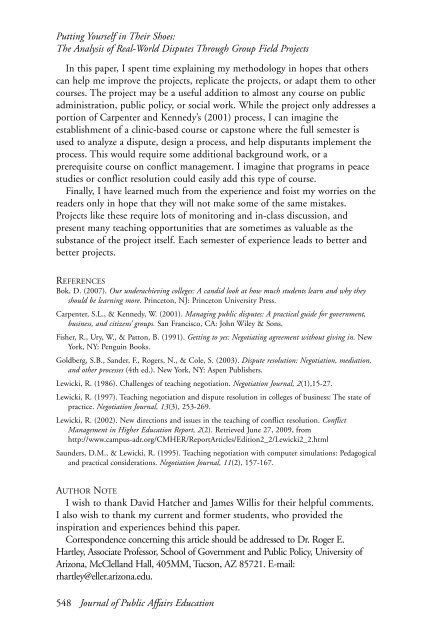JOURNAL OF PUBLIC AFFAIRS EDUCATION - National ...
JOURNAL OF PUBLIC AFFAIRS EDUCATION - National ...
JOURNAL OF PUBLIC AFFAIRS EDUCATION - National ...
You also want an ePaper? Increase the reach of your titles
YUMPU automatically turns print PDFs into web optimized ePapers that Google loves.
Putting Yourself in Their Shoes:<br />
The Analysis of Real-World Disputes Through Group Field Projects<br />
In this paper, I spent time explaining my methodology in hopes that others<br />
can help me improve the projects, replicate the projects, or adapt them to other<br />
courses. The project may be a useful addition to almost any course on public<br />
administration, public policy, or social work. While the project only addresses a<br />
portion of Carpenter and Kennedy’s (2001) process, I can imagine the<br />
establishment of a clinic-based course or capstone where the full semester is<br />
used to analyze a dispute, design a process, and help disputants implement the<br />
process. This would require some additional background work, or a<br />
prerequisite course on conflict management. I imagine that programs in peace<br />
studies or conflict resolution could easily add this type of course.<br />
Finally, I have learned much from the experience and foist my worries on the<br />
readers only in hope that they will not make some of the same mistakes.<br />
Projects like these require lots of monitoring and in-class discussion, and<br />
present many teaching opportunities that are sometimes as valuable as the<br />
substance of the project itself. Each semester of experience leads to better and<br />
better projects.<br />
REFERENCES<br />
Bok, D. (2007). Our underachieving colleges: A candid look at how much students learn and why they<br />
should be learning more. Princeton, NJ: Princeton University Press.<br />
Carpenter, S.L., & Kennedy, W. (2001). Managing public disputes: A practical guide for government,<br />
business, and citizens’ groups. San Francisco, CA: John Wiley & Sons.<br />
Fisher, R., Ury, W., & Patton, B. (1991). Getting to yes: Negotiating agreement without giving in. New<br />
York, NY: Penguin Books.<br />
Goldberg, S.B., Sander, F., Rogers, N., & Cole, S. (2003). Dispute resolution: Negotiation, mediation,<br />
and other processes (4th ed.). New York, NY: Aspen Publishers.<br />
Lewicki, R. (1986). Challenges of teaching negotiation. Negotiation Journal, 2(1),15-27.<br />
Lewicki, R. (1997). Teaching negotiation and dispute resolution in colleges of business: The state of<br />
practice. Negotiation Journal, 13(3), 253-269.<br />
Lewicki, R. (2002). New directions and issues in the teaching of conflict resolution. Conflict<br />
Management in Higher Education Report, 2(2). Retrieved June 27, 2009, from<br />
http://www.campus-adr.org/CMHER/ReportArticles/Edition2_2/Lewicki2_2.html<br />
Saunders, D.M., & Lewicki, R. (1995). Teaching negotiation with computer simulations: Pedagogical<br />
and practical considerations. Negotiation Journal, 11(2), 157-167.<br />
AUTHOR NOTE<br />
I wish to thank David Hatcher and James Willis for their helpful comments.<br />
I also wish to thank my current and former students, who provided the<br />
inspiration and experiences behind this paper.<br />
Correspondence concerning this article should be addressed to Dr. Roger E.<br />
Hartley, Associate Professor, School of Government and Public Policy, University of<br />
Arizona, McClelland Hall, 405MM, Tucson, AZ 85721. E-mail:<br />
rhartley@eller.arizona.edu.<br />
548 Journal of Public Affairs Education

















